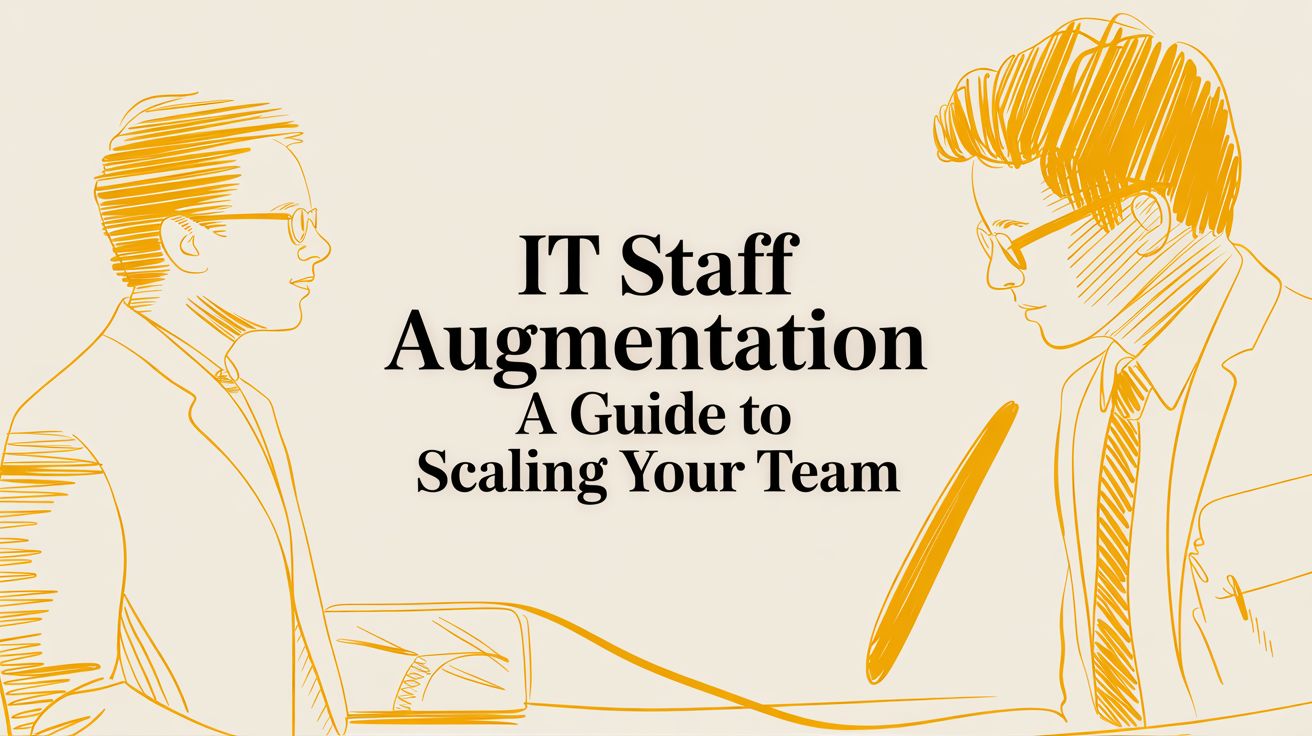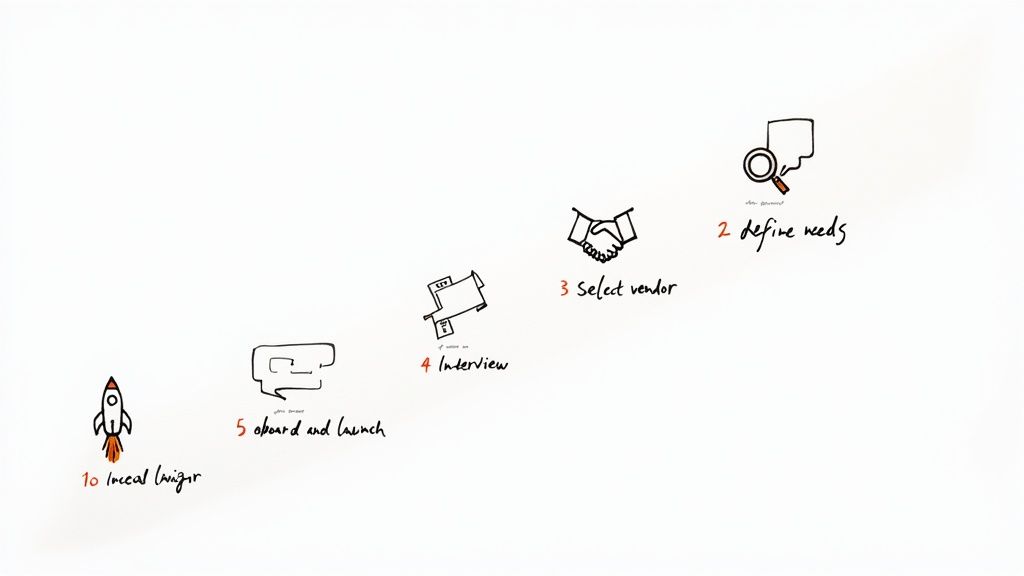IT Staff Augmentation A Guide to Scaling Your Team

Think of it this way: your team of expert chefs is slammed preparing for a huge banquet. You don't have time to go through the whole hiring process for a new full-time cook, but you desperately need a pastry specialist for this one event. You bring one in, they work alongside your team for the banquet, and then they're on their way.
That’s IT staff augmentation in a nutshell. It’s a smart, flexible way to bring skilled tech professionals directly into your team to fill a specific skills gap or just to get you through a temporary crunch.
What Is IT Staff Augmentation?

At its core, IT staff augmentation is an outsourcing strategy that lets you extend your existing in-house team with outside talent. These aren't just contractors working in a silo; they become part of your crew. They work alongside your employees, report to your managers, and slot right into your established workflows.
The big difference? The partner agency you work with handles all the administrative headaches—things like payroll, benefits, and all the HR paperwork.
This model gives you a fantastic middle ground between hiring another full-time employee and completely outsourcing a project. You get to keep full control over your project and its direction, but you also gain access to specialized skills exactly when you need them. It's no surprise this has become a go-to strategy for businesses that want to scale efficiently without the heavy overhead and long-term commitments of traditional hiring.
When Does Staff Augmentation Make Sense?
This approach isn’t a silver bullet for every problem, but it’s incredibly effective in the right situations. Knowing when to pull this lever is key to getting the most out of it.
You should seriously consider IT staff augmentation when you're up against challenges like:
- Sudden Skill Gaps: You realize you need a certified cloud architect for a six-month migration project, but you won't need that role permanently.
- Temporary Workload Spikes: Your team is staring down a tight product launch deadline and you just need more developer firepower to get across the finish line.
- Covering for Absences: A key team member is heading out on extended leave, and you need an experienced pro to step in and keep the project from stalling.
- Testing New Tech: You want to build a proof-of-concept with a new framework but aren't ready to commit to hiring a full-time expert in that technology just yet.
At its core, IT staff augmentation is about precision and agility. It allows a company to add exactly the skills it needs, for exactly as long as it needs them, without disrupting the existing team structure or long-term financial planning.
The market numbers back this up. The IT staff augmentation market is on a trajectory to skyrocket from USD 299.3 billion in 2023 to an estimated USD 857.2 billion by 2031. This massive growth is fueled by the simple need for flexible teams that can keep up with the breakneck pace of digital change.
How It’s Different from Other Sourcing Models
It’s easy to lump staff augmentation in with other outsourcing strategies, but the way they work on a day-to-day basis is fundamentally different. Getting these distinctions right is crucial for picking the model that actually fits your needs.
Here's a quick table to break down the key differences between the most common approaches.
Comparing Sourcing Models
| Factor | IT Staff Augmentation | Managed Services | Project Outsourcing |
|---|---|---|---|
| Control | High. Your team manages the augmented staff directly. | Low. You define the outcome, the provider manages the process. | Low. You hand over the entire project to a vendor. |
| Integration | High. Augmented staff work as part of your team. | Low. The provider's team works separately. | None. An external team handles the project end-to-end. |
| Responsibility | Shared. You manage the project; the provider handles HR. | The provider is fully responsible for the service outcome. | The vendor is fully responsible for the project outcome. |
| Flexibility | High. Easy to scale the team up or down as needed. | Medium. Based on a long-term service level agreement (SLA). | Low. Scope and budget are typically fixed upfront. |
| Best For | Filling skill gaps, short-term projects, scaling teams. | Managing ongoing, non-core functions like IT support. | One-off projects with clear, defined deliverables. |
As you can see, the level of control and integration is what really sets these models apart.
With project outsourcing, you essentially hand over the keys to a third-party vendor to manage an entire project from start to finish. In contrast, staff augmentation keeps you firmly in the driver's seat. Your own managers direct the augmented team members daily, making sure they're a perfect fit for your company culture and goals. For a closer look, you can explore our full comparison of staff augmentation vs. outsourcing.
It’s also different from managed services, where an external provider takes full ownership of a specific business function, like your IT helpdesk or network security. With staff augmentation, you’re simply adding people to your team—you’re not handing over control of a whole department. Think of it as supplementing your crew, not replacing a part of it.
Choosing Your Sourcing Model

So, you've decided IT staff augmentation is the right move. The next big question is a simple one: where? The geographic location of your talent—your sourcing model—is one of the most critical decisions you'll make, directly impacting everything from your budget to your daily stand-up meetings.
Think of it like choosing a supplier. You can source parts from a local factory, one in a neighboring country, or one halfway around the world. Each choice comes with a different balance of cost, speed, and logistical ease. Your project's unique demands will ultimately point you to the best fit.
The three main sourcing models are onshore, offshore, and nearshore. Let’s unpack what each one really means for your team and your bottom line.
Onshore Sourcing: The Local Advantage
Onshore staff augmentation is straightforward: you hire talent located within your own country. If you’re a U.S.-based company, your augmented team members are also in the U.S. This is, by far, the simplest path to collaboration.
The upsides are obvious. There are no language barriers, you’re operating in the same cultural context, and your time zones are perfectly synced. This makes real-time communication, brainstorming, and integrating new people into your existing team feel completely seamless.
But that convenience comes with a hefty price tag. Onshore talent is the most expensive option, reflecting the high cost of living and competitive local labor markets. It’s a great choice if the budget is no object, but it doesn’t offer the cost relief most companies are looking for.
Offshore Sourcing: Tapping into Global Talent
Offshore sourcing is when you hire professionals in distant countries, often on entirely different continents. The classic example is a company in San Francisco partnering with developers in India or Eastern Europe.
The number one driver here is major cost savings. Labor rates in popular offshore hubs can be a fraction of what you’d pay at home, which can stretch a tight budget much further. You also gain access to an enormous global talent pool.
The trade-offs, however, can be significant. Large time zone differences—often 8-12 hours—can turn a simple question into a full-day delay and make real-time collaboration a serious challenge. You also have to navigate potential cultural and language nuances that can add friction if not managed well. If you want to understand this model in a broader context, you can explore the principles of software engineering outsourcing.
Nearshore Sourcing: A Strategic Balance
This is where things get interesting. Nearshore staff augmentation strikes a smart balance between the other two models by sourcing talent from nearby countries, usually those within a similar time zone. For a business in North America, this typically means looking to talent hotspots in Latin America, like Mexico, Colombia, or Costa Rica.
Nearshore is designed to give you the best of both worlds:
- Real Cost-Effectiveness: While not as rock-bottom as some offshore rates, nearshore talent still provides substantial savings compared to hiring locally.
- Time Zone Alignment: This is the game-changer. Your team’s working hours have significant overlap, making daily stand-ups, pair programming, and quick problem-solving just as easy as with an onshore team.
- Cultural Affinity: Geographic and cultural closeness often leads to smoother communication and a more intuitive team dynamic.
The nearshore model is built for companies that need to cut costs without sacrificing the close collaboration required for agile, fast-moving projects. It’s all about minimizing friction while maximizing value.
At Nerdify, our entire model is built around this sweet spot, connecting companies with world-class engineers and developers across Latin America. To see how this approach could work for you, check out our deep dive into the specific advantages of https://getnerdify.com/blog/nearshore-staff-augmentation.
Onshore vs Offshore vs Nearshore
To make the choice even clearer, this table breaks down how the three models stack up against each other on the factors that matter most.
| Model | Cost | Time Zone Overlap | Cultural Affinity | Best For |
|---|---|---|---|---|
| Onshore | Highest | Full | High | Projects needing intense, real-time collaboration where budget is not the primary concern. |
| Offshore | Lowest | Minimal | Varies | Cost-sensitive projects with well-defined tasks that don't require constant communication. |
| Nearshore | Moderate | High | High | Agile projects seeking a balance of cost savings, talent quality, and seamless collaboration. |
Ultimately, the right sourcing model comes down to your priorities. Are you optimizing purely for the lowest cost? Do you need the tightest possible collaboration? Or are you looking for that strategic blend of both? Answering that question will tell you exactly where in the world to find your next great team member.
Here is the rewritten section, designed to sound completely human-written and natural.
The Good, The Bad, and The Smart Way to Do It
Bringing on augmented staff is more than just getting an extra pair of hands; it's a strategic move that can seriously put your projects on the fast track. The upsides go way beyond just filling a seat—it's about injecting new skills, speed, and cost-efficiency into your team.
But let's be real—like any smart business play, it has its pitfalls. The trick isn't to ignore the risks but to see them coming and have a plan. Forget a simple pros-and-cons list; let's dig into what really works and what can go wrong.
The Game-Changing Benefits of Augmentation
One of the biggest wins with IT staff augmentation is that you get to sidestep the painfully slow traditional hiring process. Instead of losing months to recruiting, interviewing, and onboarding, you can tap into a global talent pool and find a pre-vetted specialist in a matter of days or weeks. This is a lifesaver when you need a very specific skillset, like a DevSecOps engineer or an AI pro, that’s nearly impossible to find in your local market.
That speed directly translates into saving money. Think about it: all the usual costs of hiring a full-time employee—recruiter fees, benefits packages, payroll taxes, a new laptop—vanish.
With staff augmentation, you just get a single, predictable invoice each month. You’re essentially turning a major capital expense into a flexible operating cost, which makes budgeting and scaling so much simpler.
This kind of flexibility is a core advantage. You can bring on a few developers for a six-month sprint and then scale back down just as easily. You only pay for the exact talent you need, for exactly how long you need it. It’s that simple.
- Access to Niche Experts: Instantly find specialists with the precise tech skills you need, without being limited by geography.
- Slash Overhead Costs: Dodge the heavy financial burden of traditional hiring, including benefits, payroll, and equipment.
- Unmatched Scalability: Effortlessly expand your team for a big project push or shrink it during slower phases, keeping your team size perfectly matched to your workload and budget.
Navigating the Potential Pitfalls
While the benefits are huge, you can't just dive in without a plan. A smart augmentation strategy means looking potential challenges right in the eye. With a bit of foresight, you can turn these risks into non-issues and keep things running smoothly.
A common headache is making sure the new folks actually mesh with your existing team and company culture. If you just drop someone in without a proper welcome, they can feel like outsiders. That leads to communication gaps, misunderstandings, and a real drag on productivity.
Another thing to watch out for is vendor dependency. If you lean too heavily on one partner and don't have a good system for knowledge transfer, you could be in a world of hurt if that relationship ends. Your in-house team might be left holding the bag, with no idea how to maintain or build upon the work that’s been done.
Smart Solutions for Common Challenges
The good news is that these risks are completely manageable if you have the right strategies from the get-go. Instead of crossing your fingers and hoping for the best, you can put simple processes in place to build a cohesive team, protect your institutional knowledge, and stay in the driver's seat.
To get integration right, create a solid onboarding experience from day one.
- Assign an Onboarding Buddy: Pair every new augmented team member with one of your own employees. This gives them a go-to person for navigating company culture, internal tools, and project history.
- Keep Communication Central: Use a shared platform like Slack or Microsoft Teams to make sure everyone is in the same loop, no matter where they are.
- Schedule Regular Check-ins: Daily stand-ups and weekly one-on-ones aren't just for show. They create a real sense of team unity and keep everyone aligned.
To avoid getting stuck with vendor lock-in, make knowledge transfer a top priority.
- Make Documentation a Deliverable: Insist that detailed, clear documentation is a non-negotiable part of the job. This ensures that crucial project knowledge always stays with you.
- Vet Your Partners Carefully: Before you sign anything, do your homework. Look at their track record, talk to their clients, and understand their process for screening and training their people.
- Use Paired Programming: Have your in-house and augmented developers work together on key features. It's a natural way to share skills and project context without a formal handoff.
When you look at IT staff augmentation this way—as a powerful tool with manageable risks—you can build a more resilient, high-performing team that’s ready for whatever comes next.
Your Step-by-Step Implementation Plan

Moving from idea to action requires a clear, methodical plan. Bringing in new talent through IT staff augmentation isn't about just finding a warm body to fill a seat. It's a strategic process that, when done right, integrates new experts into your team seamlessly and helps them make an impact from day one.
This playbook breaks the journey down into four manageable stages to ensure you get it right. Think of it like building a high-performance engine. You wouldn't just throw parts together and hope for the best. You start with a precise blueprint, select the best components, assemble them carefully, and then fine-tune the system for peak performance.
Stage 1: Define What You Actually Need
The foundation of any successful project is a crystal-clear understanding of what you’re missing. It's easy to say you need a "senior developer," but that's far too vague. To find the right person, you have to dig deeper and create a detailed profile of the exact skills and contributions your project demands.
Start by asking yourself some pointed questions:
- What specific programming languages, frameworks, or tools are absolute must-haves?
- What's the project timeline, and how long will we need this person on board?
- Will this role require regular collaboration with non-technical stakeholders?
- What seniority level is truly required to hit the ground running with minimal hand-holding?
This detailed needs analysis becomes your North Star, guiding every decision that follows. A well-defined role description prevents miscommunication and ensures you and your potential partner are speaking the same language from the start.
Stage 2: Select the Right Vendor
With your requirements in hand, the next move is finding the right partner. The quality of your vendor will directly impact the quality of the talent you get and how smoothly the entire process runs. Not all augmentation firms are created equal, so doing your homework here is critical.
You're looking for a partner who acts more like a strategic ally than a simple resume-forwarding service.
Green Flags to Look For:
- A Rigorous Vetting Process: Ask them to walk you through their technical screening, soft skills assessments, and background checks. A top-tier partner invests heavily in pre-vetting their talent.
- Transparent Pricing: The cost structure should be simple and all-inclusive, typically a single monthly rate with no surprise fees for HR, benefits, or admin.
- Industry Expertise: A vendor with experience in your specific industry will have a much better grasp of your unique challenges and technical needs.
- Strong Client Testimonials: Look for positive reviews and detailed case studies that show a proven track record of successful placements.
On the flip side, be wary of red flags like overly aggressive sales tactics, a lack of verifiable client feedback, or fuzzy answers about their screening methods.
Stage 3: Master the Interview Process
Once your partner presents a shortlist of candidates, the interview is your chance to validate both technical skill and cultural fit. The goal isn't just to find someone who can code, but someone who can integrate into your team’s unique rhythm and workflow.
Structure your interviews to get a complete picture of each candidate:
- Technical Deep Dive: Go beyond standard Q&A. Use live coding challenges, system design problems, or a review of their past projects to see how they actually think and solve problems.
- Cultural Fit Conversation: Ask behavioral questions. How do they handle constructive feedback? How do they collaborate on tough problems or adapt when priorities shift?
- Team Introduction: Involve key members of your existing team in the final interview stages. Their perspective is invaluable for judging how well a candidate will mesh with the group.
Remember, you are hiring a new team member, not just a temporary contractor. The time you invest here will pay off in productivity and team morale down the road.
Stage 4: Ensure Seamless Onboarding and Management
The work isn’t over once the contract is signed. A structured onboarding process is the final, crucial step to get your new team members up to speed and contributing quickly. A bumpy start can lead to confusion, disengagement, and lost time.
Your onboarding checklist should cover the basics:
- Providing access to all necessary systems, software, and communication channels from day one.
- Assigning an in-house "buddy" or point person to help them navigate internal processes.
- Clearly outlining project goals, your expectations, and their specific role in hitting those targets.
Ongoing management is just as important. Make sure your augmented staff are fully integrated into all team rituals, from daily stand-ups to weekly check-ins. For a deeper look at making the relationship a long-term success, check out our guide on staff augmentation best practices.
How AI and Niche Skills Are Shaping The Future

The world of IT staff augmentation is changing. It's no longer just a quick fix for plugging temporary gaps on a project. Two big things are driving this evolution: the smart use of artificial intelligence in finding people and the skyrocketing demand for super-specialized, niche skills.
Together, these trends are completely rewriting the playbook for how companies build their tech teams. Instead of viewing augmented staff as temporary outsiders, smart companies are bringing in these experts as key players to drive innovation and stay ahead. It's less about adding headcount and more about strategically embedding the exact expertise you need, right when you need it.
The AI Revolution in Talent Sourcing
AI isn't some far-off concept anymore; it's a real tool that’s making a huge difference in how staff augmentation partners find and vet talent. Think about it: AI-powered platforms can scan millions of profiles, assess technical skills, and pinpoint the perfect person for a project with a precision that humans just can't match. This makes the entire hiring process incredibly fast.
In the past, finding a seasoned DevSecOps engineer or a machine learning specialist could take months of searching. Now, AI algorithms can identify, screen, and deliver a shortlist of qualified experts in just a fraction of that time. The numbers back this up—over 65% of recruiters already use AI in their work. The payoff is huge, with 67% of hiring pros reporting they save significant time and make better matches.
AI has turned talent sourcing from a reactive scramble into a proactive, intelligent strategy. It allows firms to build and manage curated talent pools, getting ahead of skill demands before they become emergencies.
This means when you need an expert, your partner isn't starting from square one. They’re tapping into a living, AI-managed network of professionals, getting the right person on your team faster than ever. When deadlines are tight, that speed is a massive advantage.
The Surge in Demand for Niche Expertise
At the same time, we're seeing an explosion in demand for skills that are extremely specific and hard to come by. As technology gets more complicated, the roles needed to build and manage it become more specialized. A great generalist developer is still a huge asset, but the people who truly move the needle are the experts in emerging fields.
The demand is intense for specialists in areas like:
- AI and Machine Learning: People who can actually build, train, and deploy complex algorithms.
- Cybersecurity and DevSecOps: Experts who know how to weave security into the entire development process from day one.
- Quantum Computing: Specialists who are pushing the boundaries of what's computationally possible.
- Regulatory Technology (RegTech): Professionals who live at the intersection of finance, compliance, and software development.
These skills aren’t just rare; they’re often clustered in certain tech hubs, making them nearly impossible to hire locally for most companies. This is where staff augmentation shines. It gives you a direct line to this global talent, letting you bring in a world-class expert for a specific project without the headaches of relocation or a long-term hiring commitment.
The rise of No Code AI App Builders is another perfect example. These platforms are changing the game, and staff augmentation is often the quickest way to bring in pros who already know them inside and out. It ensures your team can adopt new tools and keep innovating without skipping a beat.
Common Questions About IT Staff Augmentation
Even with a solid plan, you're bound to have some practical questions about how IT staff augmentation really works day-to-day. After all, bringing new people into your team, even temporarily, changes the dynamic. It’s smart to get the "what ifs" out of the way before you jump in.
Here, we’ll tackle the most common questions we hear from business leaders who are exploring this talent strategy. We'll give you straight, clear answers on management, security, cost, and how this all stacks up against other hiring models.
How Is IT Staff Augmentation Different From Hiring a Freelancer?
The biggest difference boils down to one word: integration.
When you hire a freelancer, you're typically paying for a specific, isolated task. They work on their own, often outside your team's daily rhythm, and once the job is done, the engagement ends.
An augmented team member, on the other hand, is woven directly into your existing team. They report to your managers, join your daily stand-ups, use your internal tools, and collaborate with your permanent employees as if they were one of your own.
Think of it like this: you hire a freelancer to build a specific component for you. You use staff augmentation to bring in an expert to join your team and build that component with them, right there in the trenches under your direction. This makes sure their work fits perfectly with your project's architecture and long-term vision.
Who Manages the Augmented Staff Members?
This is one of the best parts, and it’s a core principle that sets staff augmentation apart from other outsourcing models: you do.
You keep full control over the project and the people working on it. The augmented professionals report directly to your project managers, team leads, or product owners—whoever is running the show.
So, what does the staff augmentation partner do? They handle all the HR and administrative headaches you don't want to deal with, like:
- Payroll and Benefits: Managing compensation, taxes, and all the associated paperwork.
- Compliance and Legal: Making sure all employment contracts are buttoned up and legally sound.
- General HR Support: Acting as a safety net and support system for the professional.
This setup gives you the best of both worlds. You get to focus 100% on building great products without the heavy administrative lift of traditional hiring.
How Is Intellectual Property and Security Handled?
This is non-negotiable. Protecting your intellectual property (IP) and keeping your systems secure are top priorities. Any reputable staff augmentation partner builds their entire business on earning and keeping your trust through rock-solid legal agreements and strict security protocols.
Every engagement should kick off with a detailed Master Services Agreement (MSA) that includes strong Non-Disclosure Agreements (NDAs). The most critical clause in these contracts must state that all work product and intellectual property created by the augmented staff belongs entirely to your company. No exceptions.
On the security front, you simply extend your internal security policies to your augmented team members, just as you would for any new hire. Best practices include:
- Secure Access: Give them access to your systems through a secure VPN with multi-factor authentication (MFA).
- Principle of Least Privilege: Grant access only to the specific data and tools they absolutely need to do their job.
- Thorough Vetting: Your partner should be conducting comprehensive background checks on every professional they represent.
What Does the Cost Structure Typically Look Like?
The cost model is designed for complete transparency, helping you sidestep the hidden fees that often pop up with traditional recruiting. You'll typically see a straightforward, all-inclusive monthly rate for each person you bring on board.
That single number covers everything: the professional’s salary, benefits, payroll taxes, and the vendor's service fee. It makes budgeting a breeze because you can easily calculate your monthly spend based on how many people you have on the team.
A few key things will influence that final rate:
- Skill and Seniority: A principal engineer with a decade of experience will naturally command a higher rate than a mid-level developer.
- Location, Location, Location: Onshore talent in places like New York or San Francisco will be the most expensive, while nearshore and offshore models offer significant cost advantages.
- Contract Duration: Committing to a longer-term engagement can sometimes unlock a more favorable rate compared to a short-term project.
Ultimately, this model turns a big, unpredictable capital expense (hiring) into a flexible and manageable operating expense. You can scale your team's brainpower up or down in direct response to your project needs and budget.